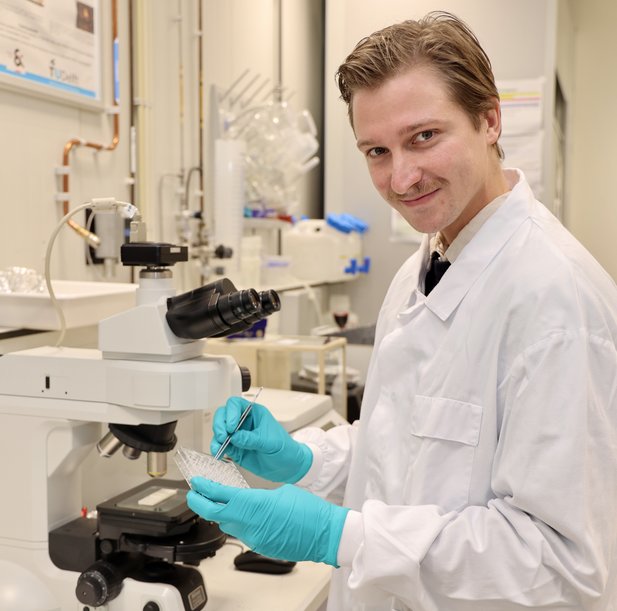Dirk Eijkel
What exactly do you do at the cutting edge of technology and healthcare?
More and more bacteria are becoming resistant to antibiotics. This means that if, at some point in the future, you insert a bone implant which is then infected by bacteria, the current range of antibiotics will no longer work, possibly necessitating amputation and perhaps leading to the death of the patient. It is unlikely that new antibiotics will be developed in time. However, biomaterials can also have antibacterial properties. And they’re often not hard to find: in this case, they occur in nature. For example, there are all kinds of nano-needles on dragonfly wings, on which bacteria die.
We would like to develop bone implants with a surface of these nano-needles, which would serve three purposes. Obviously, the surface should stimulate the growth of bone cells so that the implant is quickly integrated into the body. It should also kill bacteria, skewering them, as it were. And what is completely new is that we are aiming to use the needles to stimulate the much larger immune cells to attack bacteria. We vary the shape of the needles and then look at the shape and migration of the immune cells. We then also look at which genes in the immune cells are activated and what proteins they secrete. These are the preparations we are making for the post-antibiotic era.
I started studying physics but I then found I wanted to do more hands-on experiments. Now you have a biomaterial, with nano-needles, and that has a medical impact on a much larger scale. That makes me very much a nerd in both physics and medicine. We are currently doing experiments with flat surfaces, but eventually we want to be able to apply the needles to arbitrary three-dimensional shapes. The knowledge of my health ambassador and promoter Amir Zadpoor is indispensable in this regard. His research includes biomaterials that can mimic both the nano- and microstructures, and the mechanical properties of bone.

What is your impression of the medical world?
Doctors hold nano-needles in very high regard, because they are not substances that spread in the body and make you sick. Working in partnership with doctors in our consortium is very pleasant. They know a lot about cell biology, while we know more about biomaterials, so we complement each other very well. Their knowledge is extra important because our research is still in its early stages. It works both ways, of course: if they ask something we can very quickly say whether or not it is possible from a materials point of view.
Do you have a top tip for engineers who work in the medical field, or who would like to do so?
Sometimes just starting to develop something can turn out well. But if you want to make rapid progress, or develop something quickly, the best people to talk to are healthcare professionals because they know the real issues. By listening carefully to each other, you will find that the answer is closer than you think. That’s the great thing about working in a partnership.
And it’s still fundamental research, so it is not always about what you want or expect, and that certainly applies to cell cultures. The fact that things turn out differently can be frustrating, but the unexpected can often be a rewarding outcome.
What is completely new is that we are aiming to use nano-needles on implants to stimulate immune cells to attack bacteria
